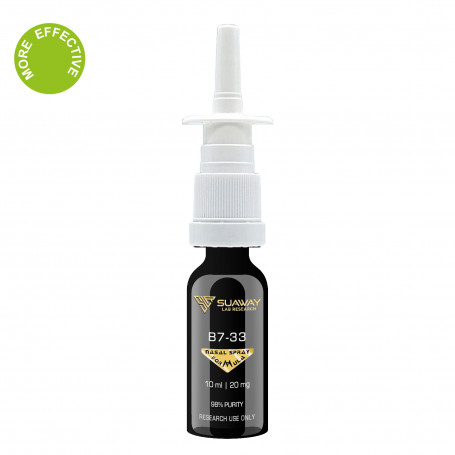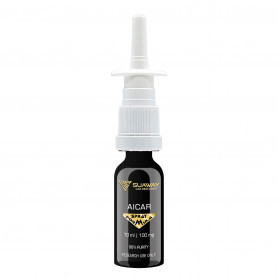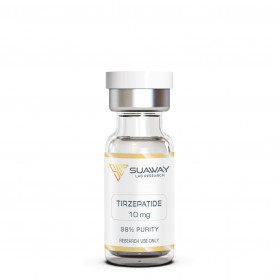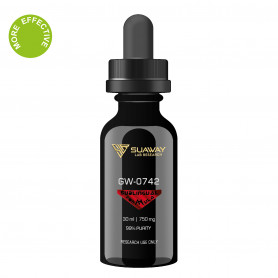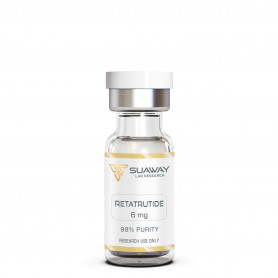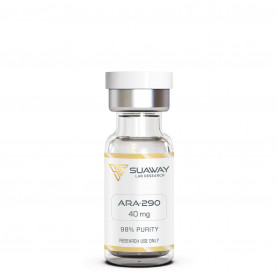B7-33 - 10ml/20mg
B7-33 exhibits a powerful anti-fibrotic effect. It has been shown that it may minimize the production of excessive scar tissue after heart damage. Additionally, it has shown potential in the treatment of certain vascular problems as well as the preeclampsia that may occur during pregnancy.
- Anti-Fibrotic Properties
- Blood Vessel Protection
- Acute heart failure
- Lung inflammation
Total Spray: 82 (244 mcg per spray)
FRESHLY PREPARED SOLUTION
Description
STRUCTURE
Sequence: VIKLSGRELVRAQIAISGMSTWSKRSL
PubChem ID: 318164840
Peptide purity: greater than 98%
Other details: No TFA Salt, No Mannitol
Storage: This product must be stored at 4°C. No suitable for freezing.
DESCRITPION
The bigger, naturally occurring protein H2-relaxin is the source of the B7-33 peptide, which is a soluble, synthetic version of a single-chain peptide. The anti-fibrotic actions of relaxin are preserved in B7-33, although it does not stimulate cAMP synthesis. Matrix metalloproteinase 2 (MMP2) production is boosted as a result of this peptide's ability to promote ERK1/2 activation, which in turn leads to the breakdown of extracellular collagen.
B7-33 is one of a variety of synthetic peptides that are generated from the human H2-relaxin protein. The human H2-relaxin protein is the namesake of a family of four proteins known as the relaxin proteins. These proteins include relaxin, insulin-like peptide 3, H3-relaxin, and insulin-like peptide 5. It has been shown that all of these proteins, which are closely linked to insulin, have pleiotropic effects, meaning that they have an effect not only on the musculoskeletal system but also on the cardiovascular system and reproduction.
The four endogenous receptors for the relaxin family of peptides are grouped into two pairs, designated RXFP1/2 and RXFP3/4, respectively. The following is an explanation of the functions performed by these receptors:
- RXFP-1: Important functions in sperm motility, pregnancy, the endothelium of the circulatory system, and the health of joints
- RXFP-2: Plays an important function in testicular descent
- RXFP-3: Schizotypal personality disorder and particular sleep difficulties have both been linked to the discovery of mutated forms of this receptor
- RXFP-4: The function of this receptor is not completely understood. It is known to be expressed in sperm and to affect the action of insulin-like peptide 5, which has been shown to have a role in the signaling of satiation and hunger.
According to the findings of recent research, relaxin not only has all of the features that were previously described, but it also acts as a vasodilator, a stimulant of blood vessel development, and an antihypertrophic. When considered as a whole, these actions provide relaxin with powerful anti-fibrotic characteristics. As a result, this peptide and its derivatives are now the subject of intensive research for its potential use in the treatment of acute heart failure and other fibrotic illnesses.
Even though B7-33 binds to the RXFP1 receptor with more affinity than the natural H2-relaxin protein, B7-33 preferentially activates the pERK pathway over the cAMP pathway. This is because B7-33 has a unique structure that allows it to do so. It is well known that the pERK pathway plays a significant part in the stoppage of the cell cycle in the G1 phase. Additionally, this route has been linked to a variety of disorders, including protein-misfolding syndromes such as Alzheimer's disease and Crutzfeld-Jacob disease.
At least half of all chronic illnesses progress to a condition known as fibrosis, which may be loosely described as scarring or the disorganized regeneration of tissue. Abnormal wound healing, also known as fibrosis, is one of the key factors that lead to organ failure in a variety of conditions, including cardiovascular disease, lung illness, and cirrhosis of the liver. The H2-relaxin drug completed phase II of its clinical trials in 2012 for the treatment of acute heart failure. According to the findings of the study, the injection of H2-relaxin results in immediate vasodilatory effects and lowers the long-term scarring that is evident after injury to the heart. Because of this, H2-relaxin is the first novel medication for acute heart failure to be given the green light in the last 20 years.
The use of the entire relaxin protein as a treatment comes with several limitations, although the benefits of H2-relaxin are substantial and strong. Not only is it difficult to manufacture H2-relaxin, but it can also only be supplied by intravenous injection. In addition, it has been shown that the complete protein causes an increase in heart rate and promotes the growth of cancer (particularly prostate cancer). Because the majority of these effects can be linked back to the activation of the cAMP pathway by the protein, an attempt has been made to lessen the amount of cAMP activation. The outcome of such efforts is the number B7-33.
According to Dr. Akhter Hossain, one of the primary researchers who worked on the development of B7-33, the peptide boosts the synthesis of MMP-2 similarly to how H2-relaxin does, or perhaps somewhat more so. In rat models of MI-induced heart failure, this naturally translates into a considerable decrease in cardiac fibrosis. Because of the decrease in fibrosis, there is a corresponding improvement in heart function, and as a result, there is a reduction in the symptoms and consequences of heart failure over the long run. According to the findings, B7-33 may lower the total amount of scarring in the heart caused by damage by around fifty percent. In mice models of asthma and lung fibrosis, researchers found that the same effects were seen.
To do more research on the advantages that B7-33 has over H2-relaxin, Dr. Hossain and his colleagues observed the effects of administering B7-33 to mice that already had prostate cancer. As it turns out, B7-33 did not stimulate the formation of tumors when it was given in levels that were required to treat fibrosis. Furthermore, it did not promote the growth of tumors when it was given in dosages that were greater than those that had anti-fibrotic effects. This is because B7-33 does not promote the synthesis of cAMP and instead functions nearly solely via the pERK pathway.
The potential of human relaxin-2 (serelaxin) to protect the vasculature from edothelial malfunction and long-term scarring has made it the subject of intensive concentration in laboratory studies. According to studies conducted on male Wistar rats, the vasoprotective effects of serelaxin may be mimicked by B7-33 via an increase in bradykinin's ability to promote endothelium-dependent relaxation in arterial smooth muscle. Because of the molecule's selectivity in producing vasorelaxation, it has the potential to be effective in the treatment of specific cardiovascular disorders, including preeclampsia, which may occur during pregnancy.
Preeclampsia is a frequent pregnancy condition that may result in high blood pressure and a smaller-than-normal weight gain for the fetus. Although it is possible to regulate preeclampsia to some extent, the condition may be challenging to manage and, in extreme circumstances, poses a danger to the lives of the mother and the fetus. Because preeclampsia is one of the most prevalent causes of premature birth, it is vital to deliver the baby as soon as possible in the most severe forms of the condition. However, research indicates that relaxin, and by extension B7-33, may be effective in preventing and treating preeclampsia, even in more severe instances.
According to the most current studies that have been conducted in this field, B7-33 most likely stimulates an increase in VEGF synthesis in cytotrophoblasts by acting at the RXFP-1 receptor. These cells, which may be detected in the developing fetus, play an essential role in facilitating the establishment of blood flow from the maternal circulation to the growing fetus. The synthesis of VEGF is stimulated by B7-33, which in turn encourages the formation of blood vessels and, as a result, enhances the blood flow between the mother and the kid.
REFERENCES
M.A. Hossain et al., "A single-chain derivative of the relaxin hormone is a functionally selective agonist of the G protein-coupled receptor, RXFP1" [PubMed]
S.A. Marshall et al., "B7-33 replicates the vasoprotective functions of human relaxin-2 (serelaxin)" [PubMed]
R.J. Summers "Recent progress in the understanding of relaxin family peptides and their receptors" [NCBI]
DISCLAIMER
This product is intendend for lab research and development use only. These studies are performed outside of the body. This product is not medicines or drugs and has not been approved by the FDA or EMA to prevent, treat or cure any medical condition, ailment or disease. Bodily introduction of any kind into humans or animals is strictly forbidden by law. This product should only be handled by licensed, qualified professionals.
All product information provided on this website is for informational and educational purposes only.

